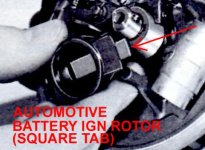There appears to be a bit of confusion here. To assure that all of us are on the same page about the ignition system.... check the following and let us know which you have.
Automotive ignition = Distributor cap attaches to the top of the distributor... plug wires exit the top sides of the cap.
Magneto ignition = Distributor cap attaches to the bottom of the distributor... plug wires exit straight down out of the bottom of the cap.
The 1966 V4 would have a two barrel downdraft carburetor. There would be two brass high speed jets located horizontally way behind those two 7/16" slotted hex head drain bolts you see at the bottom front of the carburetor. Clean them carefully with a piece of single strand steel wire... they must be perfectly clean. Adjust the slow speed needle valves as follows:
(Carburetor Adjustments - Older V/4 Downdraft Carb)
(J. Reeves)
NOTE: The early model downdraft carburetors incorporated "Adjustable High Speed Jets". The later model downdraft carburetors used "Fixed High Speed Jets". The high speed jets would be located in back of the two bottom drain screws. Follow the below instructions accordingly.
NOTE: If you do not have adjustable high speed jets, ignore those paragraphs pertaining to same...... BUT do make sure that you manually inspect and clean the two brass fixed high speed jets which would be located in back of the two 7/16" slotted hex head bolts in the bottom front portion of the float chamber.
Lift the center High Speed Control lever and turn it so that the point faces forward, resting on the high ridge. This will disengage the lever control gear from the individual high speed jets (slots). Have the slow speed needle valve knobs installed upside down so that they can be turned without encountering any obstruction.
Gently seat each of the High Speed needle valves, then back each one out one (1) turn. Gently seat each of the Slow Speed needle valves, then back each one out one and one half (1-1/2) turns. NOTE... have the jam nut on the s/speed needles snug so that vibration won't have any effect on them, but loose enough so that you can turn them without a great amount of effort.
(High Speed)
With a reliable person at the wheel, and one kneeling in front of the engine, start the engine (yes, it will run lousy with the above initial needle valve settings), put it into forward gear, and apply full throttle. Start with the High Speed adjustment on the left using a screwdriver that properly fits the slot.
(High Speed Adjustments)
At full throttle, with the proper size screwdriver, slowly start turning one of the H/S needles in segments of 1/8 turn, waiting momentarily for the engine to respond, then repeat turning. You will reach a point where the engine will start to die out. At that point, back that needle valve out approximately 1/4 turn. Now, go to the other High Speed needle valve and repeat that procedure. At some point in that 1/4 turn out, you will find the smoothest high speed setting (you can now lower the throttle rpm). That will have both high speed needle valves set correctly, and at that point you can lift that center lever adjustment of that high ridge, keeping it lifted until the point is facing the engine, then lower it into its proper position. (When you turn that lever now, you're adjusting both High Speed needle valves at the same time.)
(Slow Speed Adjustments)
Now, lowering the rpms of course, take the engine out of gear and set the throttle just to where the engine will stay running. Again, in segments of 1/8 turn, slowly start turning in one of the slow speed needle valves, waiting a few seconds between each turning for the engine to respond. As you turn the s/speed needles in, the rpms will increase..... and as it does, lower the rpms to where the engine will just stay running (otherwise the rpms will climb quite high). You will reach a point whereas the engine will either start to die out or it will spit back (sounds like a mild backfire). At that point, back the needle valve out 1/4 turn. Repeat the process with the remaining slow speed needle. Again, at some point in that 1/4 turn out, you will find the smoothest setting. When finished, tighten the jam nut somewhat, then remove and reinstall the s/speed knobs correctly (right side up).


